Discount retailer Five Below (NASDAQ:FIVE) missed analysts' expectations in Q4 CY2023, with revenue up 19.1% year on year to $1.34 billion. Next quarter's revenue guidance of $836 million also underwhelmed, coming in 1.8% below analysts' estimates. It made a GAAP profit of $3.65 per share, improving from its profit of $3.07 per share in the same quarter last year.
Five Below (FIVE) Q4 CY2023 Highlights:
- Revenue: $1.34 billion vs analyst estimates of $1.35 billion (0.9% miss)
- EPS: $3.65 vs analyst expectations of $3.78 (3.5% miss)
- Revenue Guidance for Q1 CY2024 is $836 million at the midpoint, below analyst estimates of $851.5 million
- Management's revenue guidance for the upcoming financial year 2024 is $4.02 billion at the midpoint, missing analyst estimates by 2.2% and implying 12.9% growth (vs 15.1% in FY2023)
- Gross Margin (GAAP): 41.2%, up from 40.3% in the same quarter last year
- Free Cash Flow of $304.6 million, similar to the same quarter last year
- Same-Store Sales were up 3.1% year on year
- Store Locations: 1,544 at quarter end, increasing by 204 over the last 12 months
- Market Capitalization: $11.41 billion
Often facilitating a treasure hunt shopping experience, Five Below (NASDAQ:FIVE) is an American discount retailer that sells a variety of products from mobile phone cases to candy to sports equipment for largely $5 or less.
A typical store is around 8,000 square feet in size, located in a suburban shopping center or mall. Overall, stores are bright and colorful, with a layout that encourages customers to browse and discover new products. One prominent section in most stores is tech, where customers can find headphones, charging cables, and phone cases. There is also usually a section for beauty and personal care products. Toys and snacks are two other prominent sections, with the latter located near the checkout area to encourage impulse purchases.
The company's core customer base is young adults and teenagers who are looking for affordable yet trendy products. For example, when the colorful rubber ‘pop it’ or ‘push pop’ product became popular among children, Five Below jumped on the trend and featured the products prominently in its toy sections. This customer base also values the treasure hunt experience of walking a Five Below store. So while the store’s sections are consistent, the products sold in each section may vary over time and will depend on what’s hot and what the company can source and sell within its price and margin guardrails.
Discount General Merchandise Retailer
Broadline discount retailers understand that many shoppers love a good deal, and they focus on providing excellent value to shoppers by selling general merchandise at major discounts. They can do this because of unique purchasing, procurement, and pricing strategies that involve scouring the market for trendy goods or buying excess inventory from manufacturers and other retailers. They then turn around and sell these snacks, paper towels, toys, and myriad other products at highly enticing prices. Despite the unique draw and lure of discounts, these discount retailers must also contend with the secular headwinds of online shopping and challenged retail foot traffic in places like suburban strip malls.
Retail competitors include TJX (NYSE:TJX), Urban Outfitters (NASDAQ:URBN), and Ollie’s Bargain Outlet (NASDAQ:OLLI).Sales Growth
Five Below is a mid-sized retailer, which sometimes brings disadvantages compared to larger competitors benefiting from better economies of scale. On the other hand, it has an edge over smaller competitors with fewer resources and can still flex high growth rates because it's growing off a smaller base than its larger counterparts.
As you can see below, the company's annualized revenue growth rate of 17.8% over the last four years (we compare to 2019 to normalize for COVID-19 impacts) was excellent as it added more brick-and-mortar locations and increased sales at existing, established stores.
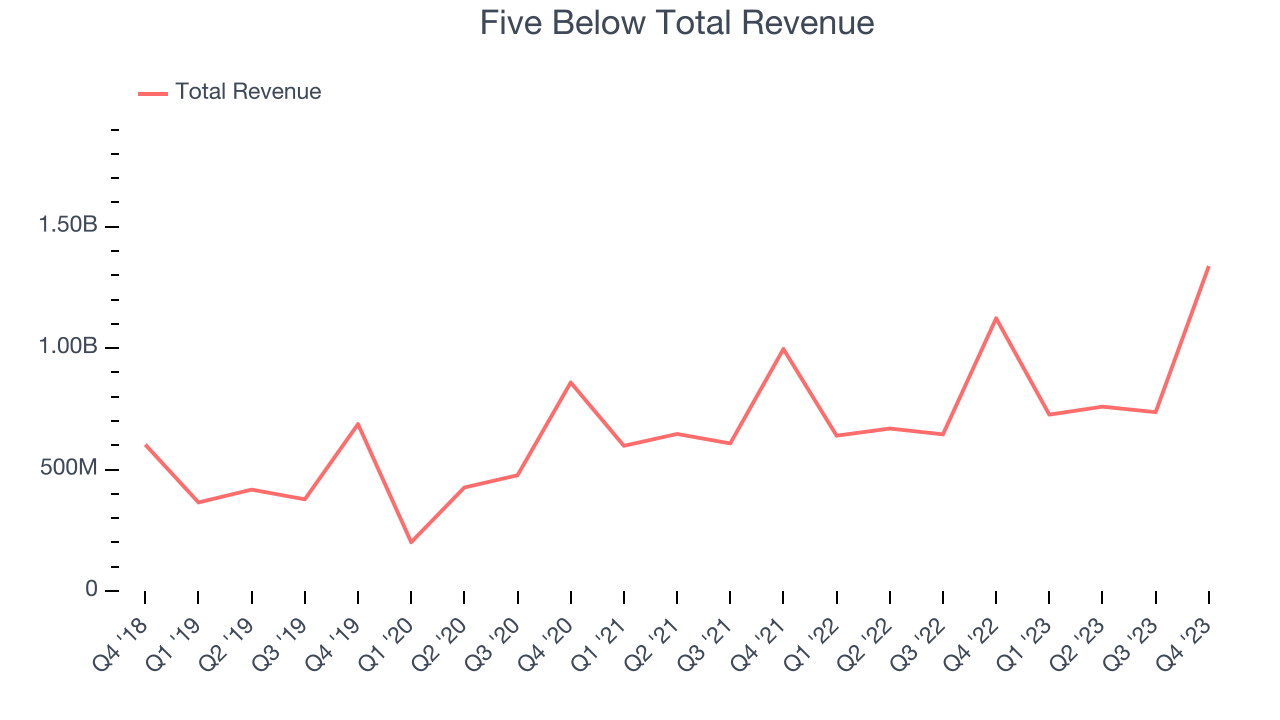
This quarter, Five Below's revenue grew 19.1% year on year to $1.34 billion, falling short of Wall Street's estimates. The company is guiding for revenue to rise 15.1% year on year to $836 million next quarter, improving from the 13.5% year-on-year increase it recorded in the same quarter last year. Looking ahead, Wall Street expects sales to grow 15.5% over the next 12 months, a deceleration from this quarter.
Number of Stores
The number of stores a retailer operates is a major determinant of how much it can sell, and its growth is a critical driver of how quickly company-level sales can grow.
When a retailer like Five Below is opening new stores, it usually means it's investing for growth because demand is greater than supply. Five Below's store count increased by 204 locations, or 15.2%, over the last 12 months to 1,544 total retail locations in the most recently reported quarter.
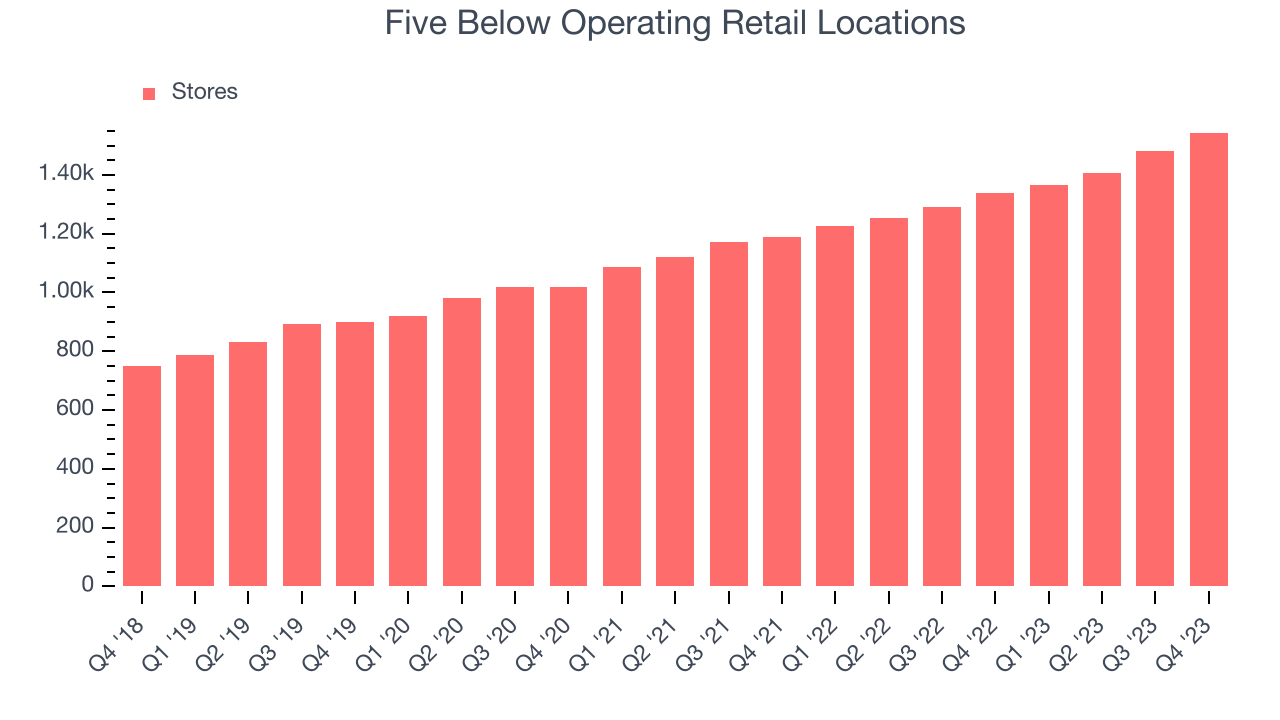
Taking a step back, the company has rapidly opened new stores over the last eight quarters, averaging 12.6% annual growth in its physical footprint. This store growth is much higher than other retailers and gives Five Below an opportunity to become a large company over time. With an expanding store base and demand, revenue growth can come from multiple vectors: sales from new stores, sales from e-commerce, or increased foot traffic and higher sales per customer at existing stores.
Same-Store Sales
Five Below's demand within its existing stores has barely increased over the last eight quarters. On average, the company's same-store sales growth has been flat. This performance suggests that Five Below should consider improving its foot traffic and efficiency before expanding its physical footprint.
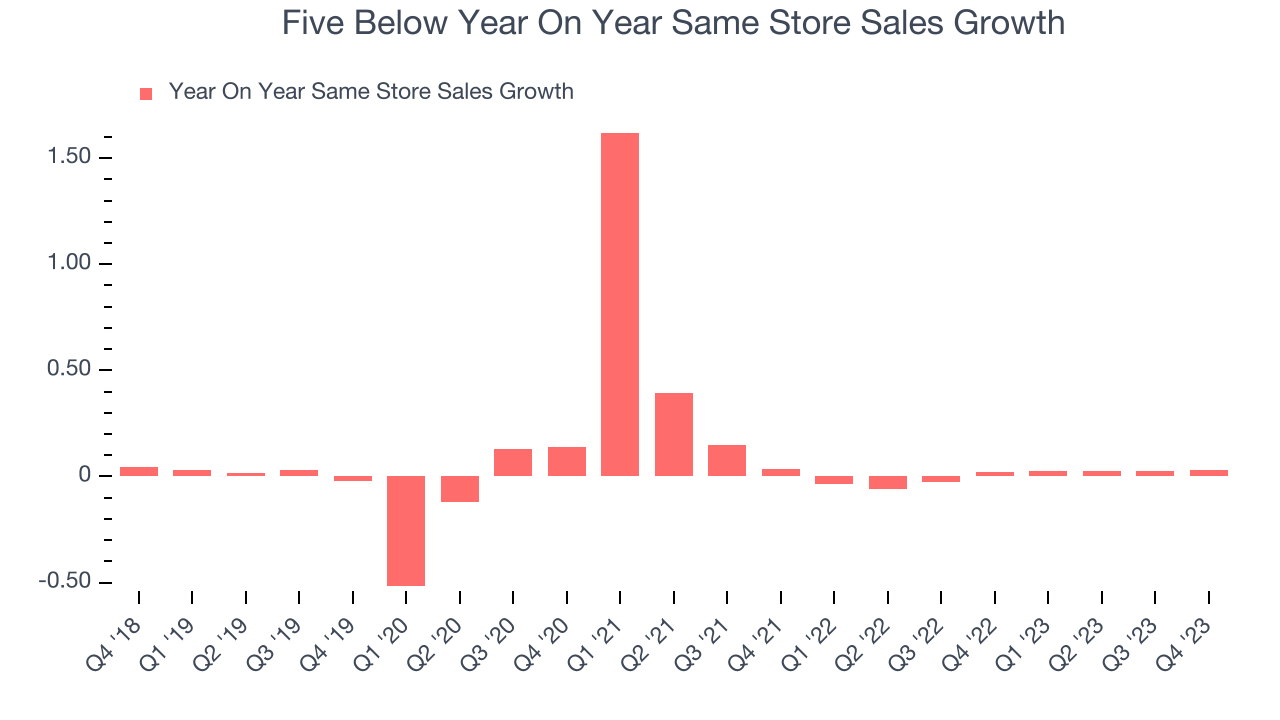
In the latest quarter, Five Below's same-store sales rose 3.1% year on year. This growth was an acceleration from the 1.9% year-on-year increase it posted 12 months ago, which is always an encouraging sign.
Gross Margin & Pricing Power
We prefer higher gross margins because they make it easier to generate more operating profits.
Five Below's unit economics are higher than the typical retailer, giving it the flexibility to invest in areas such as marketing and talent to reach more consumers. As you can see below, it's averaged a decent 35.7% gross margin over the last eight quarters. This means the company makes $0.36 for every $1 in revenue before accounting for its operating expenses.
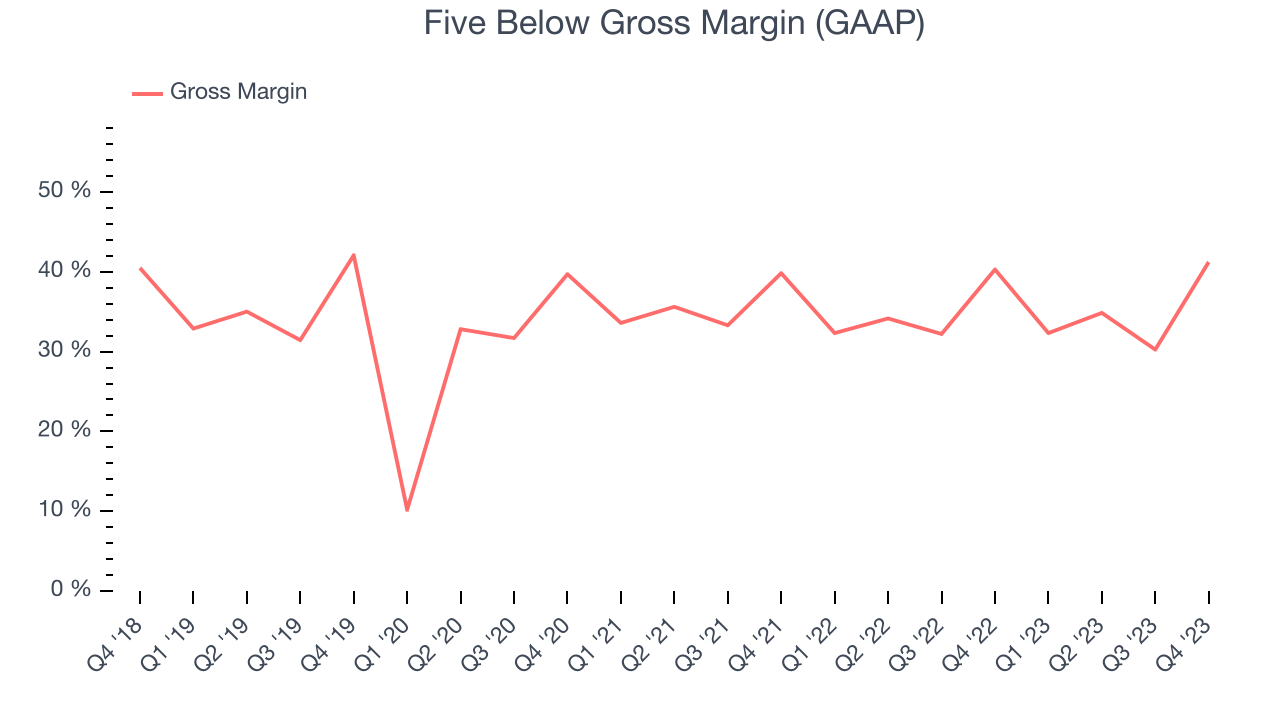
Five Below produced a 41.2% gross profit margin in Q4, flat with the same quarter last year. This steady margin stems from its efforts to keep prices low for consumers and signals that it has stable input costs (such as freight expenses to transport goods).
Operating Margin
Operating margin is a key profitability metric for retailers because it accounts for all expenses keeping the lights on, including wages, rent, advertising, and other administrative costs.
In Q4, Five Below generated an operating profit margin of 20.1%, in line with the same quarter last year. This indicates the company's costs have been relatively stable.
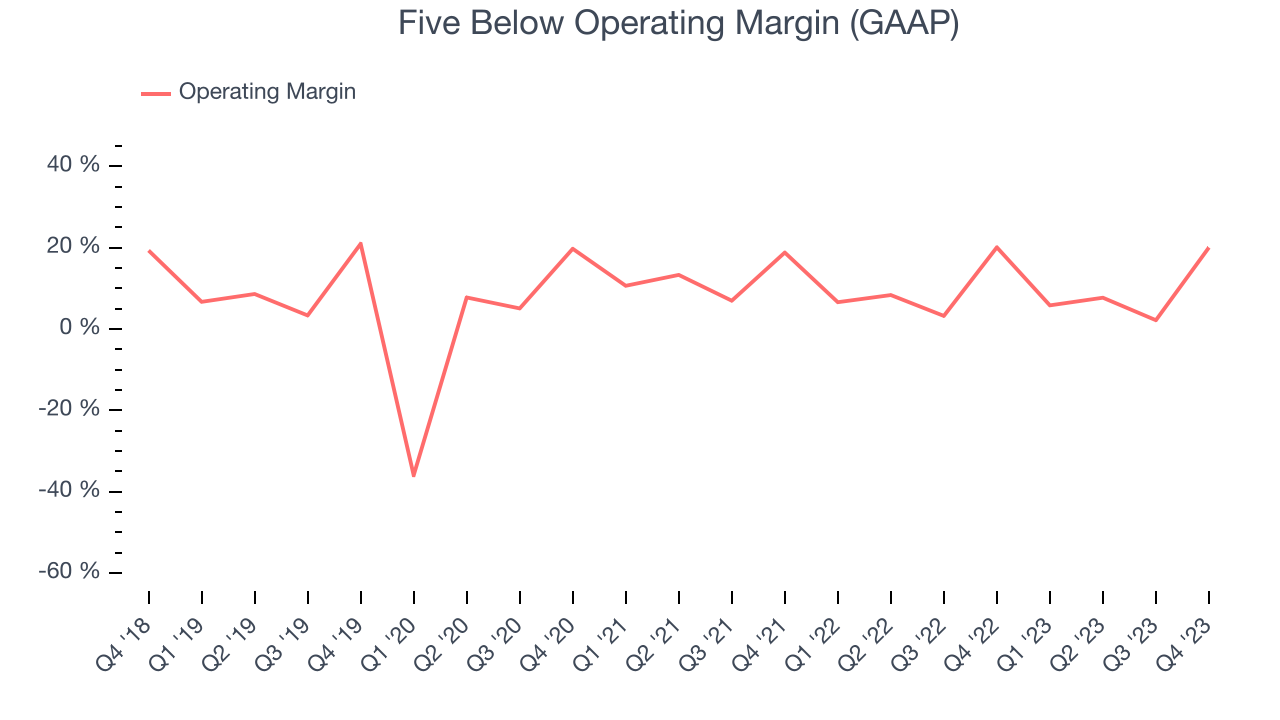 Zooming out, Five Below has managed its expenses well over the last two years. It's demonstrated solid profitability for a consumer retail business, producing an average operating margin of 11%. On top of that, its margin has remained more or less the same, highlighting the consistency of its business.
Zooming out, Five Below has managed its expenses well over the last two years. It's demonstrated solid profitability for a consumer retail business, producing an average operating margin of 11%. On top of that, its margin has remained more or less the same, highlighting the consistency of its business. EPS
Earnings growth is a critical metric to track, but for long-term shareholders, earnings per share (EPS) is more telling because it accounts for dilution and share repurchases.
In Q4, Five Below reported EPS at $3.65, up from $3.07 in the same quarter a year ago. This print unfortunately missed Wall Street's estimates, but we care more about long-term EPS growth rather than short-term movements.
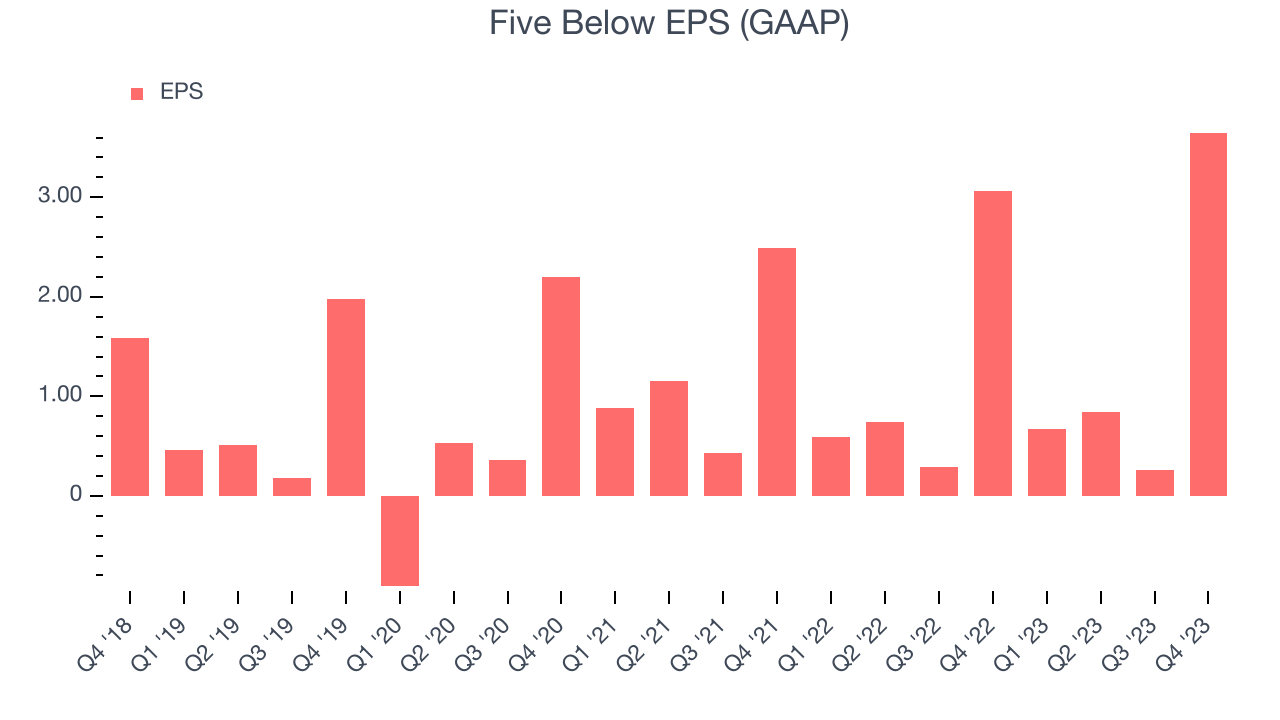
Between FY2019 and FY2023, Five Below's adjusted diluted EPS grew 73.5%, translating into a decent 14.8% compounded annual growth rate.
Wall Street expects the company to continue growing earnings over the next 12 months, with analysts projecting an average 19.6% year-on-year increase in EPS.
Cash Is King
If you've followed StockStory for a while, you know that we emphasize free cash flow. Why, you ask? We believe in the end, cash is king, and you can't use accounting profits to pay the bills.
Five Below's free cash flow came in at $304.6 million in Q4, up 8.2% year on year. This result represents a 22.8% margin.
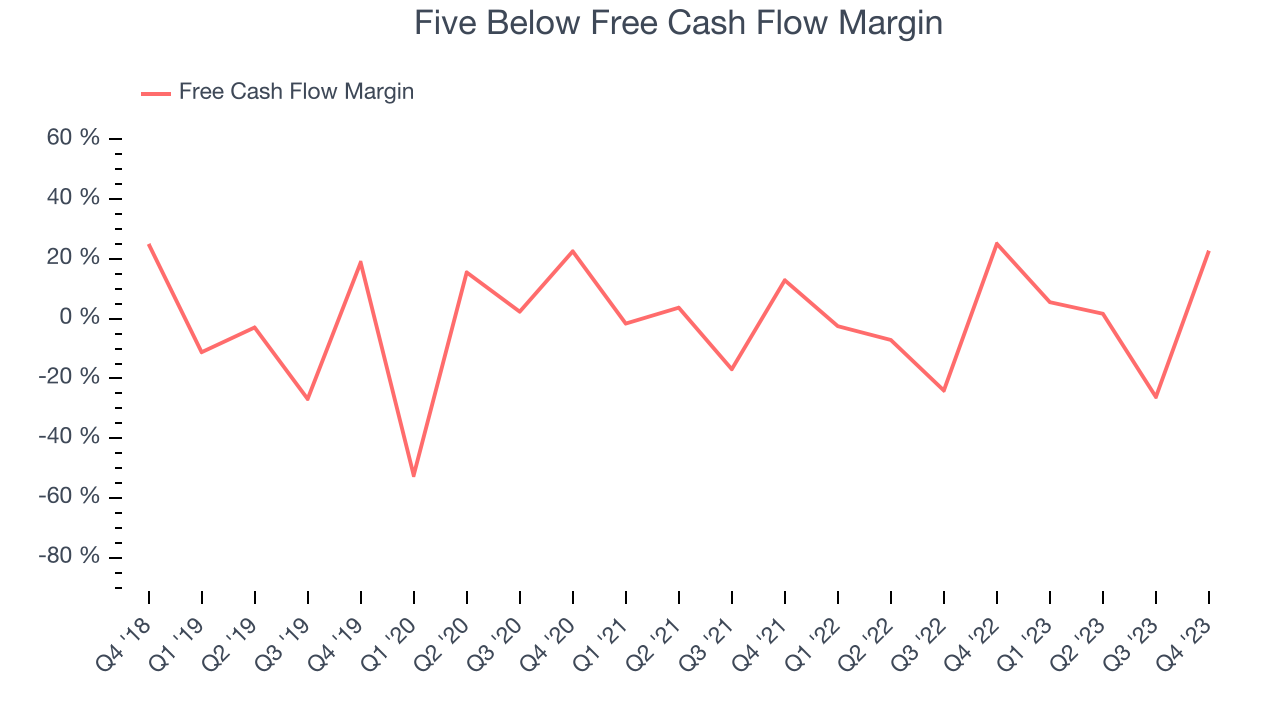
Over the last two years, Five Below has shown decent cash profitability, giving it some reinvestment opportunities. The company's free cash flow margin has averaged 3.4%, slightly better than the broader consumer retail sector. Furthermore, its margin has averaged year-on-year increases of 2.6 percentage points. This likely pleases the company's investors.
Return on Invested Capital (ROIC)
EPS and free cash flow tell us whether a company was profitable while growing revenue. But was it capital-efficient? Enter ROIC, a metric showing how much operating profit a company generates relative to how much money the business raised (debt and equity).
Five Below's five-year average ROIC was 11.6%, somewhat low compared to the best retail companies that consistently pump out 25%+. Its returns suggest it historically did a subpar job investing in profitable business initiatives.
The trend in its ROIC, however, is often what surprises the market and drives the stock price. Unfortunately, Five Below's ROIC has stayed the same over the last two years. If the company wants to become an investable business, it will need to increase its returns.
Key Takeaways from Five Below's Q4 Results
We struggled to find many strong positives in these results. Its revenue and EPS slightly missed analysts' estimates, but most importantly, its full-year 2024 revenue and earnings guidance fell short. Investors are punishing the stock for its weak outlook, and the company is down 12.4% on the results. It currently trades at $183 per share.
Is Now The Time?
Five Below may have had a tough quarter, but investors should also consider its valuation and business qualities when assessing the investment opportunity.
We have other favorites, but we understand the arguments that Five Below isn't a bad business. First off, its revenue growth has been impressive over the last four years. And while its poor same-store sales performance has been a headwind, its new store openings have increased its brand equity.
Five Below's price-to-earnings ratio based on the next 12 months is 32.2x. There are things to like about Five Below and there's no doubt it's a bit of a market darling, at least for some investors. But it seems there's a lot of optimism already priced in and we wonder if there are better opportunities elsewhere right now.
Wall Street analysts covering the company had a one-year price target of $221.86 per share right before these results (compared to the current share price of $183).
To get the best start with StockStory, check out our most recent stock picks, and then sign up to our earnings alerts by adding companies to your watchlist here. We typically have the quarterly earnings results analyzed within seconds of the data being released, and especially for companies reporting pre-market, this often gives investors the chance to react to the results before the market has fully absorbed the information.
